Also called the sacred cat of Burma, the Birman—so named to avoid confusion with the Burmese— was officially recognized only in the 1950s. Although this magnificent cat has no more divine ascendance than any other cat breed, its deep blue eyes, very special colour pattern, patient and affectionate nature, and unknown and almost mystical origins clearly explain why it is named the sacred cat of Burma.
Morphology and appearance
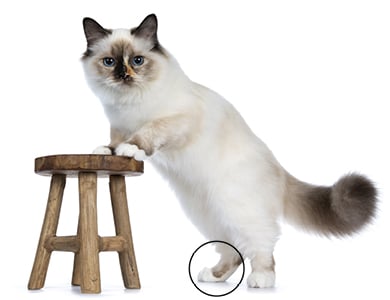
Despite its average size, the Birman is rather imposing, with its solid bone structure and massive body. Its head is, however, well-proportioned: it is rather large and round, not pointed or flat. Its tail is not too short or too long. Its large round paws are also well-proportioned in relation to the rest of its body. Its ears are as wide at the base as they are tall and its eyes, almost rounded, are well-spaced and always blue. When viewed in profile, the Birman has a distinctive Roman nose.
The Birman is characterized mainly by the colour of its coat: it always has the colourpoint pattern, with the pure white “gloves” on each paw. These white gloves cover only the paws, except for the back legs, where they form an inverted V (referred to as the “laces”) that extends half to three-fourths up the hock. Its medium-long coat with virtually no undercoat is very silky, contributing to the Birman’s spectacular appearance.
Level of maintenance (grooming)
Although rather long, the Birman’s hair rarely gets tangled because of the cat’s almost non-existent undercoat. A weekly brushing may be enough in terms of maintenance. Start getting your cat used to being brushed at a young age and always make grooming sessions enjoyable. This will help your cat increasingly enjoy being brushed and allow you to share this pleasant time more often.
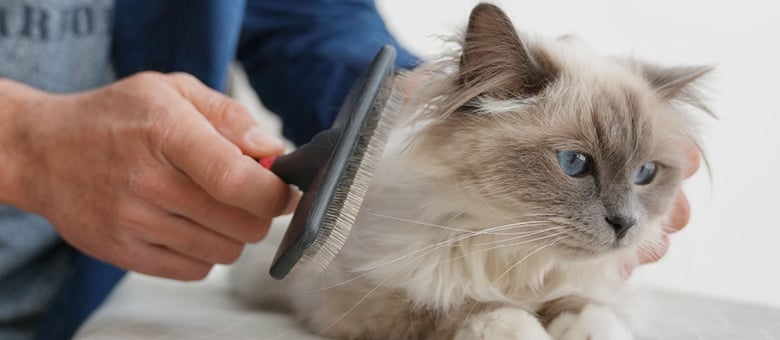
Behaviour
The Birman generally has a well-balanced temperament and adapts well to its environment, provided the cat’s needs are met. Some Birmans are gentle and affectionate, some are more playful, and still others are a bit more timid. Choosing a cat whose personality is a good match for your family is a great way to find the ideal pet.
Origins
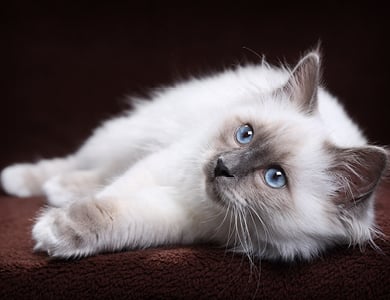
Still today, the origins of the Birman remain unclear and full of legends. According to one of these legends, a priest and his yellow-eyed white cat lived in a Burmese temple built in honour of a golden goddess with sapphire blue eyes. When the old priest lay dying, the faithful cat gave him comfort. Suddenly, the hair on the cat’s head, legs and tail darkened, and its body turned a golden colour. The soul of his master passed into the body of the cat still resting on its master’s body. The cat’s paws remained an immaculate white as a symbol of the priest’s pure spirit. As the cat gazed at the statue of the temple goddess, its eyes turned sapphire blue, just like those of the goddess. When the cat later died of sorrow, all the other temple cats were similarly transformed, giving birth to the sacred cats of Burma.
Several stories also attempt to explain the arrival of the Birman in Europe. Some stories mention cats given as a reward for helping defend a temple. Another pair of cats were said to have been stolen from a Burmese temple and later imported to France. Some prefer to remain more vague about the region in Asia that Birman cats’ ancestors come from.
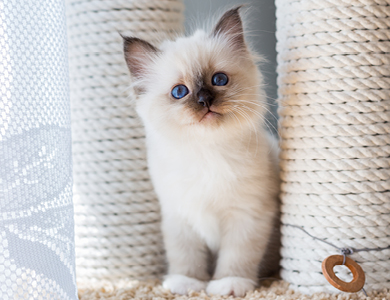
The first historic facts about the Birman date back to France in 1920. But there again, it’s unclear whether, at the time, they arrived in France from some region in Asia or whether they were the result of crossbreeding Siamese with Persian cats, both very French, one of which would have had white gloves.
As with a number of other cat breeds in Europe, Birmans were almost wiped out as a breed during World War II. One pair of survivors is apparently responsible for the re-emergence of the breed, and all Birmans in the world at present would have descended from that couple. Needless to say, breeders’ tremendous efforts, along with some crossbreeding with Persians, were needed to limit inbreeding. The breed then crossed several seas and an ocean in the 1960s, winning over the hearts of the English and the Americans around the same time.
Unusual facts
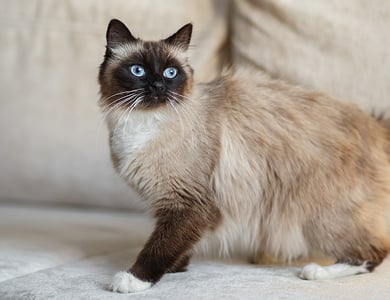
A study dating back to 2008 showed that Birmans have one of the lowest levels of genetic diversity (of all the breeds studied).
Like all colourpoint breeds, Birman kittens are born entirely white. They begin developing their points after 7 days if a dark colour and after 14 days if the points are clear or light-coloured.
The genetics behind the Birman’s white gloves are still not fully understood. They are likely the result of a set of genes that interfere with one another. This genetic trait differs from the so-called mitted ragdoll, which has white elsewhere than on the paws.
Many Birman breeders adopt the French tradition of giving their kittens names that start with a specific letter, which changes every year. All the kittens born in 2020, for example, have names that start with the letter R.





